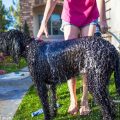We all love our dogs, but most of us don’t love anything about their fleas. At this point, you might be balking and saying, “what? MY dog doesn’t have fleas!” Well, you might be right at the moment, but you won’t necessarily remain right forever.
Any dog can acquire parasites, especially if they spend a lot of time outside. As fleas are the most common, your dog will always be at risk here.
Sure, the risk isn’t that high as far as your dog’s health is concerned (fleas are pretty normal for them), but there is another risk that is often overlooked: The possibility that your home and its carpets will become infested with those horrible little bloodsuckers.
Table of Contents
- What Are Fleas? What Do They Look Like?
- How To Get Rid Of Fleas? Natural and Chemical Treatment Solutions
- Conclusion
- FAQs
What Are Fleas? What Do They Look Like?
Fleas are small wingless insects that live like vampires (i.e., by draining the blood from living creatures). As everyone knows, they are so tiny that you can only just barely see them. This aids their survival and feeding, as they are able to hide in the thick fur of an animal and remain there for a long time.
If you look up a picture of a flea, you will see an ugly-looking creature indeed. Their body is covered in a chitinous exoskeleton, which has an “overlapped” look like lamellar armor. Their mouthparts are like sharp hooks that allow them to attach themselves to the host. Fleas make their living by sucking and consuming the blood of that host.
Interestingly, it seems that most of this bloodsucking will occur while the host is sleeping or relaxing. It seems that fleas tend to drink blood when they feel relaxed, and it’s probably hard to relax when your home is jumping and running around the back yard.
The Life Cycle Of A Flea
The life cycle of a flea is also a good thing to understand here, as this will give you valuable intelligence regarding how to defeat them. A flea will go through four stages of development: egg, larva, pupa, and adult. This cycle begins when one of their disgusting females lays her eggs after mating. These eggs will be laid right after the female has eaten a large (for her) amount of blood from the host. Without this engorging, she will not be able to lay healthy eggs.
Each egg is slightly smaller than a grain of sand, and they are laid in bunches consisting of about 20 eggs each. A single adult female flea can lay up to 40 eggs per day, and most of them do not stay on the dog. The majority of these eggs will fall off and end up somewhere in the dog’s living environment. That’s why they say, “if you lie down with dogs, you wake up with fleas!”
For fleas on an indoor dog, the carpet presents a golden opportunity for reproduction. A thick carpet is especially good (for them) since it gives the eggs more depth in which to sink. This pads them from impact and from discovery by other insects who might eat them. The eggs will hatch more quickly in warm weather, and the usual interval is anywhere from 2 days to 2 weeks.
Once the eggs hatch, the young will spend the next 5-20 days as larvae. They are like blind little white worms that can only live by eating the waste of larger fleas. Then, they spin a little cocoon and undergo metamorphosis. Once they enter that cocoon, they enter the pupa stage. At this point, the pupa will stay in the cocoon for anywhere from weeks to years. The proximity of a potential host seems to be the thing that wakes them up.
Why Not Just Get Rid Of The Carpet?
So, we should probably ask ourselves this question: What about hard flooring? If you get rid of all your carpet, will it be impossible for fleas to infest your home? Unfortunately, this doesn’t seem to be a viable alternative. It is true that hard floors provide fewer places for fleas to hide. However, there are still places in which they can hide.
All hard flooring is made of small pieces fitted together, and there will always be tiny gaps between them. These gaps might not be wide enough to bother you, but they are plenty large enough for a family of fleas.
That little crack between your floorboards is the equivalent of a mansion in the hills for them. Besides, you still have cloth on your bodies, on your furniture, and (probably) hanging on the wall. All of these represent places in which a flea infestation can take hold. Getting rid of the carpet in your home is likely to slow the infestation, but it’s not a real cure.
How To Get Rid Of Fleas? Natural and Chemical Treatment Solutions
Now that you understand your flea problem a little better, we need to talk about how you can remove that problem for good. Fleas will bite humans, although we are not their natural prey, and this is a serious annoyance.
On a more serious note, all those fleas running around biting everyone and everything can act as a serious vector for disease. Besides, your dog deserves to live without their constant annoyance.
Anti-Flea Spray Is A Good Start
First of all, you might want to invest in some household anti-flea spray. These are just products that are sprayed around the home for the purpose of killing fleas and/or their eggs. This is a pretty simple solution (even if it isn’t a stand-alone solution). What we mean is that a spray won’t be enough to solve the problem, but it can definitely help.
The idea is to create an environment that isn’t so welcoming to the little buggers. Here is one good example of a household flea spray that has proven to be very effective. We recommend this one in particular because of its high safety factor. It’s made from all-natural ingredients, and it poses no risk to your pets.
Making Your Dog A Less Appealing Target
The most effective solution is to get an anti-flea pill at the veterinarian’s office. There are many variations, but all of these medicines are effective at keeping fleas away from your dog. There are also all sorts of flea repelling solutions that can be applied to your dog’s skin (Frontline is probably the most common brand). Flea collars are, of course, another option. However, we advise against putting pesticide chemicals on your dog’s body as a general rule.
Let’s not forget about the importance of regular bathing. A good flea bath won’t solve the whole problem, but it will at least kill and remove the fleas that are present on your dog’s body. Anything that reduces their population size can only be a good thing, and your dog will get some relief. Any good flea shampoo will do the trick, but a lot of people have found that standard dawn dish liquid (just the regular blue stuff, no additives) does a great job of suffocating and killing those annoying insects. Here is also some moth-repellent ideas if you are fighting with them as well.
In any case, the solution to this problem lies with the dog itself. It is the dog who attracts the fleas, and therefore, that is the root of the problem. By doing things to make your dog a less appealing target for fleas, you will also make your home a less appealing residence for them. As for your carpets. we would recommend that you steam clean those suckers with a little bit of anti-flea spray added to the mix. It would be hard to imagine anything surviving that.
If All Else Fails: Bug-Bomb The Place
In a really extreme case, you may have to fumigate the premises. This is done using what is normally called a “flea bomb.” They call it a “bomb” because it blankets the whole area in a pesticidal substance. This will require you to temporarily vacate your home.
Obviously, this requires a lot of preparation in order to do it effectively. You also have to wash anything made of cloth that isn’t getting bombed. Basically, you remove anything that will be damaged by the chemicals and clean it at a separate location. As the name implies, this is very much a “nuclear option” that should only be used when all else fails.
Conclusion
There are plenty of good ways to get rid of fleas, and we have tried to give you a solid overview of them. These tiny little invaders are some of the most irritating pests that your home can possibly see, and we want to help you get rid of these and other pests as soon as possible.
To that end, you should study the information here and learn all that you can. Even when it comes to the disgusting stuff about flea reproduction, you can benefit from knowing your enemy a little better. Once you understand your enemy, it should be pretty easy to defeat them for good.
FAQs
Vacuum, wash bedding (yours and your pets’), and use anti flea products as soon as you can.





